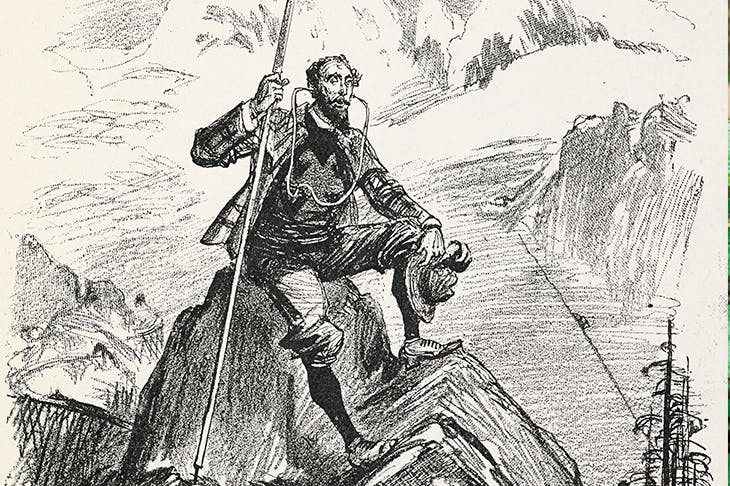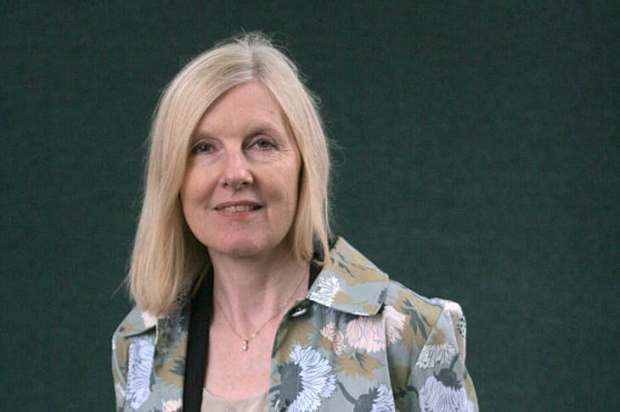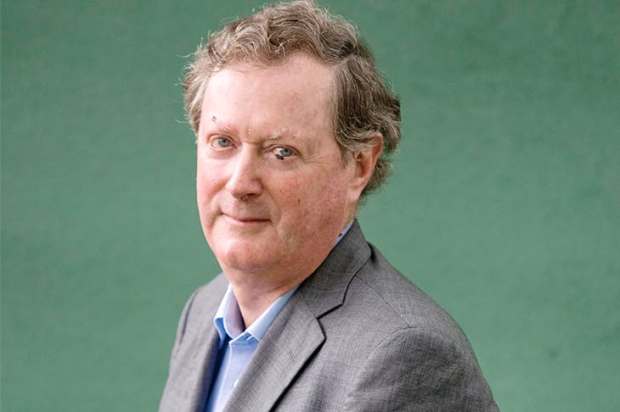pkkkfffffffrrrffff-ffff! pkkkfffffffrrrffff-fff!
Hobble leg, hobble leg,
Hobble leg owhmmm!
Into the bottle of fluff, rubbed the stuff under!
pkkkfffffffrrrffff-ffff! pkkkfffffffrrrffff-fff!
This is the voice of Tennyson reading ‘The Charge of the Light Brigade’, as recorded by Thomas Edison in 1890 and phonetically or farcically transcribed in a novel by Nicholson Baker over a century later. Drowned in static, ‘valley of death’ sounds like ‘bottle of fluff’, ‘rode the six hundred’ becomes ‘rubbed the stuff under’ and ‘Hobble leg owhmmm’ is — of course — ‘Half a league onward’. It’s as if Edison had invented a machine for dismantling sense, or a mechanical ‘medium’ for psychical research (nonsense and disembodied voices both being High Victorian hobbies), bringing messages from an already posthumous laureate.
Verse came first in the recorded history of the voice, because the tinfoil cylinder could only play for a few minutes, and was suited to nursery rhymes or snippets but not much else. ‘Mary had a little lamb’ were the first infant words that Edison’s brainchild repeated back to him, in December 1877. We need to recover a sense of the technological comedy and hauntedness of that moment.
Uncertainties surrounding the new medium were more than acoustic, and The Untold Story of the Talking Book is their secret history. Audio was ashamed of itself from the start, an apologetic alternative to reading. Even now a whiff of illegitimacy lingers: when Colm Tóibín compares reading to listening as ‘the difference between running a marathon and watching a marathon on TV’ you know what he means.
The confusion of terms is itself telling — the absence of a stable word for an act of listening that is also a version of reading. And what to call the results? Phonographic books, talking books, recorded books, spoken word, books on tape, audiobooks — the names mark the eureka moments of cylinder, shellac, LP, cassette and CD download. And what is this voice in our ear: reader, speaker, performer, voice actor, narration artist? The problem is that print long ago colonised ‘voice’, ‘narrator’ or ‘reader’ for its higher purposes.
Matthew Rubery says that thinking about audiobooks always raised questions about the fate of reading: it ‘brings out the Saint Augustine in us all’, referring to the latter’s puzzled description of Bishop Ambrose: ‘When he read, his eyes scanned the page and his heart explored the meaning, but his voice was silent and his tongue was still.’ This moment in AD 384 is often used to bolster the idea — or myth — that the ancients read aloud even to themselves and that silent reading only arrived in the early Christian era, as a spiritual exercise.
Perhaps reading aloud to oneself, pre-Gutenberg, was a need to parse spaceless and unpunctuated scripts. Whatever the case, at some point reading was silenced — and then came Edison. Or this at least was the claim. Subsequent proselytisers for books that talk also enlisted pre-history for their purposes, dignifying the spoken word as both a return to a golden Homeric age of orality and a brave new world for print.
Edison dismissed silent reading as amateurish (his curious notion was that no book is ever read with the inner voice its author intended), whereas the talking book could inculcate correct associations, an ultimately perfectible medium for the written word. The image of a silent reader dogged by poor elocution begs questions, to do with the printed voice of a literary work and its reproducibility. If we ask ourselves at a given moment ‘who is speaking?’ in a novel, the answer is often that no one is speaking. The narrative is speaking, rather than the narrator or characters, and we assent to this as part of the unspoken contract between author and reader.
The audiobook penetrates these farther shores with difficulty, and was acutely aware from the first that many of the keys to reading cannot be handed over to the listener, because they are inaudible: punctuation cannot be read out, nor typography, nor the line-breaks in a poem, nor its visual shapes. T.S. Eliot wrote that poetry, ‘whatever else it may or may not be’, is a system of punctuation. So too is prose.
Prior to audiobooks, reading aloud (to others) was of course the familial or public face of the book as entertainment. Being read to — now a forgotten interactive human technology — differs from machine listening, because like all good monologues it involves two characters, a speaker and an other, and incorporates noises off or silences, the human voice dithering and deliberating. Audio edits out such things (leaving us oddly to our own devices). Like radio, it has always been an anxious medium, hedged about with proprieties, and Rubery explores them all.
The evidences for a history of the spoken word are fugitive (audio leaves few traces), but he has made excellent use of archival resources — the correspondence of institutions for the blind or record companies; newspapers, manuals and album sleeves. The emphasis is on technology and social impact. This is above all an oral history: the public and commercial bodies involved, the selection process, how books have been read aloud and how listeners have responded.
Edison’s anticipations were more influential than what he could achieve with the phonograph. The recording of an entire novel — that talismanic aspiration — had to wait until the 1930s. When it came it was under the auspices of the American Foundation for the Blind, and in Britain the National Institute for the Blind, and was motivated by social conscience. Not initially towards the blind as such, who had braille, but rather towards servicemen newly blinded in the first world war.
The Library of Congress sent the first talking books to readers in October 1934, and in Britain a similar service started a year later. Commercial sale was prohibited, in both cases, as was their use by sighted people (who were presumably honour-bound to leave the room). The blind were champions but also sceptics, the latter in defence of braille as a discipline, which involves deciphering an abstract code for speech, like reading.
Conventions were in place from the outset: straight narration, in a normal voice, at normal speed, ‘sympathetically but with restraint’ (whereas radio favoured theatricality), the underlying idea being that a talking book unabridged is ‘a spoken version of a book, but also a bookish version of speech’. The taboo on impersonation raised questions of gender, race, minority voices, west coast or east coast, provincial or metropolitan. Reading voices were often too white, too male, too old, too straight; the norm was surprisingly rigid, and consented to as such, partly to distance the whole business from entertainment.
Selection was a hotter topic. The institutions claimed democratic empowerment but courted paternalism. Was the talking book ‘a way of reading to blind people or a way of reading for blind people?’ The idea of a free press for the blind was fought over, especially the right to listen to bad books, or ‘bald’ books (for Ulysses, Madame Bovary or Tristram Shandy it was a case of let them eat braille). During the Cold War, censorship was resisted by the Library of Congress, but the question hovered as to whether federal funds should be subsidising subversion, or instead promoting patriotism. Selection committees representative of the wishes of blind readers came about only after years of activism by readers themselves.
Rubery mentions the institutional reasons given for books deemed ‘unrecordable’ in the years between the Chatterley ban and the Beatles’ first LP: foreign setting, accent too difficult, no woman reader available, minority appeal, too crude, too dated, too difficult, too disturbing, too fantastic, too personal for listeners with fatal illnesses, too political. Or just ‘impossible to read aloud’ — usually code for too filthy. Muriel Spark’s The Prime of Miss Jean Brodie, published in 1961, a triumph of indiscreet discretion, was deemed ‘not read-aloudable’, as if sex read out were more disturbing than sex unvoiced.
The commercialisation of the talking book would eventually embrace all tastes, but it had to overcome the stigma of ‘books for the blind’ and then the limitations on playing time. Long-playing vinyl became available from 1948, and studios began using magnetic tape, which could be edited, unlike phonograph recording from acetate masters. The way forward was clear for ventures like the exemplary Caedmon Records, set up in 1952 by two cosmopolitan New Yorkers with a taste for literary modernism and a mission to create ‘a mass-produced high culture’, which included sermons, fairy tales or radio plays.
Their first LP was of Dylan Thomas and their new idea was authors reading their own work. ‘Spoken word’ became the preferred term, to indicate the authorial voice as real presence, warts and all. Recording now aspired to be the purer medium. The liner-notes to Stories of Kafka, recorded by Lotte Lenya in 1962, suggest that ‘the ear will follow each detail with the precision of Kafka’s own grim imagination, losing nothing’. Excerpts from Finnegans Wake were ‘the only way of arriving at an experience of this book’, a work which uses print as a mode of reproduction but not as its living principle.
With Caedmon, ‘the ear’ becomes the term of choice — an organ more high-minded and attentive than the avid but wandering eye, and purged of the messy contingencies implied by ‘listener’. (Harold Bloom would later employ the same exalted register to express scepticism about audiobooks: ‘deep reading really demands the inner ear’.) Caedmon was a sophisticated operation: Rubery even quotes a suggestion that they engineered the signal-to-noise ratio so that it mimicked the black and white of the printed page, ‘effectively functioning as an analogue to the printed word’.
After LPs came ‘books on tape’, dreamt up in 1975 by an entrepreneur stuck in traffic, once again in response to a new technology. The cassettes were rented out, because they were too expensive to sell outright, but also to suggest the new magic of disposability: a mobile library of easy listening at the intersection of suburbs, freeways and commuters, catering to successful people alone in cars. Rubery ends by considering the future for nonhuman narration, and the impasse of ‘the uncanny valley’ (if synthetic voices are too lifelike they become obscurely transgressive).
He also considers the rise of ‘audiobook’ as the neutral and inclusive term, and Audible as its universal purveyor. In this new dispensation, recording tries hard to forget its dependency on print: abridging, adapting, enhancing, recruiting A-list narrators (Nicole Kidman ‘performs’ To the Lighthouse) and above all duplicating. Thus the Battle of the Emmas, in advance of the release of the Miramax film in 1996, or the five new recordings of Tess of the D’Urbervilles in 2008 alone.
Duplication is not diversity, and the vast current Audible catalogue is oddly parochial (little European or other literatures in translation, little essayistic writing or short fiction or minor classics). The old Caedmon list had a more adventurous idea of literary kinds. Rubery’s book is the more important, then, for rescuing an occluded story and one that is easily forgotten. Despite its lumbering title, The Untold Story of the Talking Book is lucidly researched and written — and more suggestive than it gives itself credit for. There are enough hints to show that Rubery might have written a bolder and more speculatively charged book, but he has included the signposts.
Got something to add? Join the discussion and comment below.
Get 10 issues for just $10
Subscribe to The Spectator Australia today for the next 10 magazine issues, plus full online access, for just $10.
You might disagree with half of it, but you’ll enjoy reading all of it. Try your first month for free, then just $2 a week for the remainder of your first year.














Comments
Don't miss out
Join the conversation with other Spectator Australia readers. Subscribe to leave a comment.
SUBSCRIBEAlready a subscriber? Log in